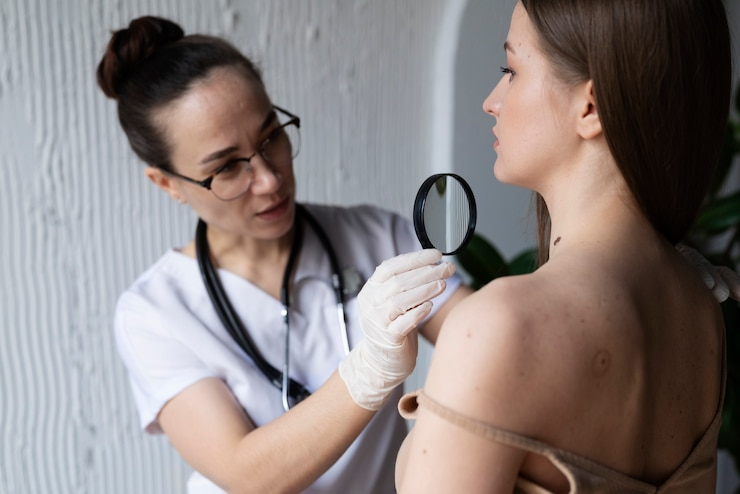Moles are a common skin concern, but it’s important to know which ones are harmless and which require a doctor’s attention. This guide will equip you with the knowledge to understand moles and melanoma, the most serious form of skin cancer.
What Are Moles?
Moles, also medically called nevi, are growths on the skin. They develop when melanocytes, the pigment-producing cells in your skin, cluster together instead of dispersing throughout the skin. Most moles appear in childhood and adolescence, and adults typically have between 10 and 40 moles. They can be brown, black, tan, or even pink, and can be flat, raised, smooth, or bumpy.
What Is Skin Cancer?
Skin cancer arises when abnormal cells in the skin grow out of control. There are three main types of skin cancer, and while most are highly treatable when caught early, melanoma is the most aggressive form.
Types of Skin Cancer
- Melanoma: This is the least common but most serious type of skin cancer. It develops from melanocytes and can spread to other parts of the body if left untreated.
- Squamous Cell Carcinoma: This type arises from squamous cells, which make up the outer layer of your skin. It usually appears on sun-exposed areas and is highly treatable when detected early.
- Basal Cell Carcinoma: The most common form of skin cancer, basal cell carcinoma, develops from the basal cells in the deepest layer of the epidermis (top layer of skin). It grows slowly and rarely spreads, but it can cause significant scarring if left untreated.
- Merkel Cell Carcinoma: This is a rare and aggressive form of skin cancer that develops in the Merkel cells, which are touch receptors in the skin.
Melanoma Signs
Melanoma can develop anywhere on the body, so it’s important to be familiar with the warning signs. Remember the “following” rule
- Asymmetry: One half of the mole doesn’t match the other.
- Border irregularity: The edges of the mole are ragged, blurred, or notched.
- Color variation: The mole has multiple colors, such as brown, black, tan, red, white, or blue.
- Diameter: The mole is larger than the size of a pencil eraser (6 millimeters).
- Evolving: The mole changes in size, shape, or color over time.

It’s important to note that not every mole that exhibits these signs will be cancerous. However, if you notice any of these changes, it’s crucial to see a doctor for evaluation.
Determining if a Mole is Cancerous: 5 Warning Signs
While the below rule is a helpful guide, there are other signs to watch for:
- Bleeding: If a mole starts to bleed for no apparent reason, see a doctor.
- Itching or tenderness: Moles that become itchy or tender can be a cause for concern.
- Oozing: If a mole oozes pus or any other fluid, consult a doctor.
- Halo: A mole surrounded by a white or inflamed area might be cancerous.
- New moles: New moles that appear later in life, especially after age 50, should be checked by a doctor.
Risk Factors and Causes of Melanoma
The exact cause of melanoma is unknown, but certain risk factors increase your chances of developing it. These include:
- Fair skin: People with fair skin, red or blond hair, and blue or green eyes are more susceptible.
- Sun exposure: Excessive ultraviolet (UV) radiation from the sun or tanning beds is a major risk factor.
- Atypical moles: Having many atypical moles (dysplastic nevi) increases your risk.
- Family history: If a close family member has had melanoma, your risk is higher.
How is Melanoma Diagnosed?
Doctors diagnose melanoma through a skin examination and may recommend a biopsy, where a small sample of the mole is removed and examined under a microscope.
When to See a Doctor
If you notice any changes in a mole or any of the warning signs mentioned earlier, schedule an appointment with your doctor. Early detection is crucial for successful treatment of melanoma.

Reduce Melanoma Risk
Here are some steps you can take to reduce your risk of melanoma:
- Limit sun exposure: Avoid the sun during peak hours (10 am to 4 pm) and wear protective clothing, including a hat and sunglasses.
- Sunscreen: Apply broad-spectrum sunscreen with SPF 30 or higher daily, even on cloudy days.
- Self-examination: Regularly examine your skin for any changes in moles.
- Professional skin checks: Get your skin checked by a doctor at least once a year.



